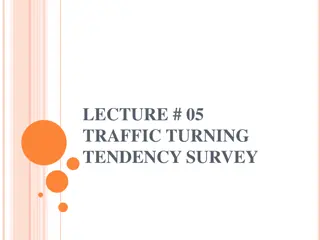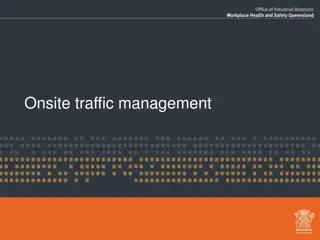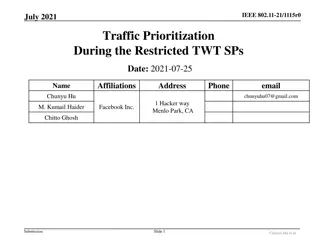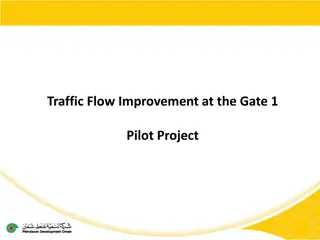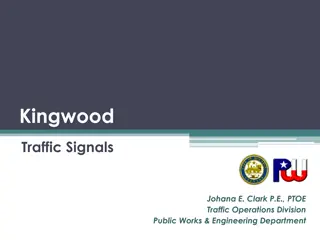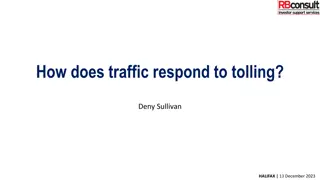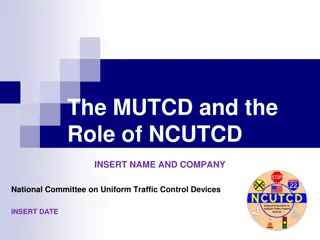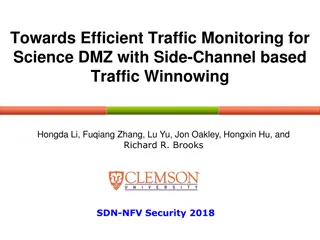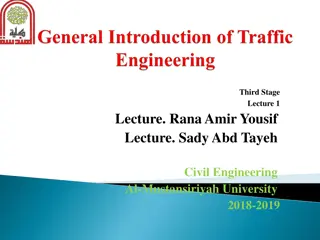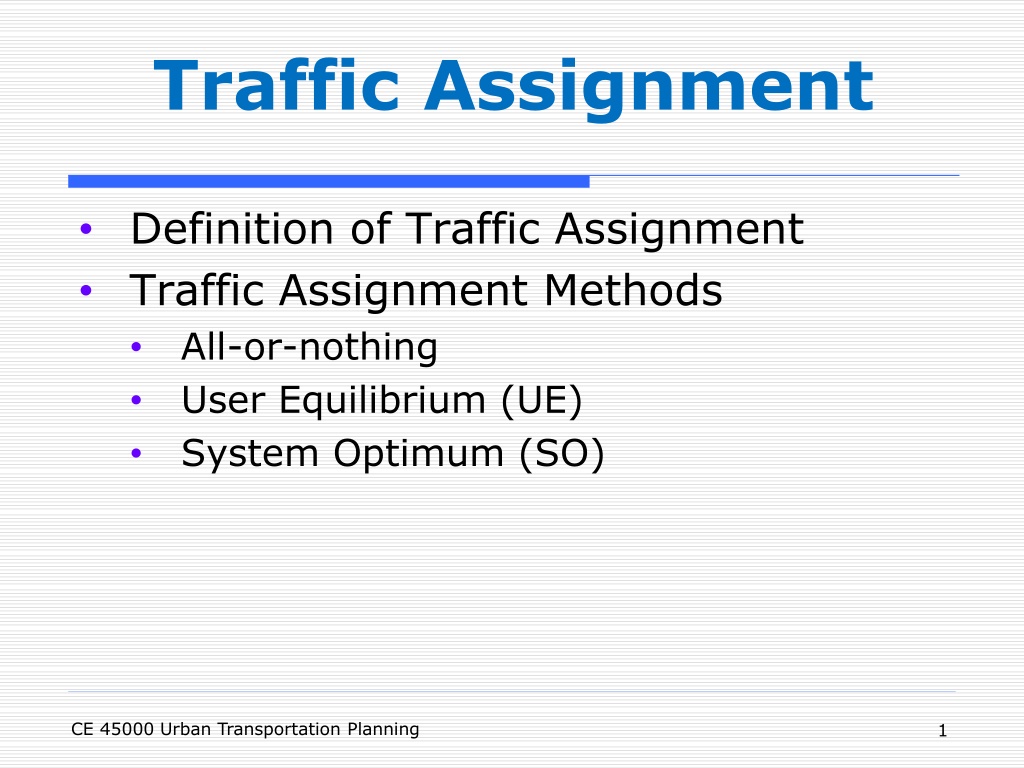
Urban Transportation Planning and Traffic Assignment Methods
Explore traffic assignment methods in urban transportation planning, including All-or-Nothing, User Equilibrium, System Optimum, and more. Learn about route determination and traffic volume estimation for O-D pairs in roadway networks.
Download Presentation

Please find below an Image/Link to download the presentation.
The content on the website is provided AS IS for your information and personal use only. It may not be sold, licensed, or shared on other websites without obtaining consent from the author. Download presentation by click this link. If you encounter any issues during the download, it is possible that the publisher has removed the file from their server.
E N D
Presentation Transcript
Traffic Assignment Definition of Traffic Assignment Traffic Assignment Methods All-or-nothing User Equilibrium (UE) System Optimum (SO) CE 45000 Urban Transportation Planning 1
Roadway Network CE 45000 Urban Transportation Planning 2
Traffic Assignment Determine routes used for O-D pairs with number of automobiles & transit vehicles on highway segments Determining expected traffic volumes on links Data required: Number of trips between zone pairs (from trip distribution) Available highway/transit routes between zones Travel times on each route Decision rule (algorithm) to determine route selection External trips not considered in trip distribution CE 45000 Urban Transportation Planning 3
Traffic Assignment Models Primary models: All-or-nothing assignment User Equilibrium (UE) assignment System Optimum (SO) assignment Capacity restraint assignment Dynamic assignment CE 45000 Urban Transportation Planning 4
All-or-nothing Traffic Assignment One path between every O-D pair Travel time is constant, does not depend on congestion or traffic flow. No congestion / capacity restraint T1= 10 mins 1 2 Total Traffic =12 T2= 15 mins CE 45000 Urban Transportation Planning 5
All-or-nothing, example CE 45000 Urban Transportation Planning 6
All-or-nothing, Steps Step 3: Continue until trips between all TAZ pairs have been assigned Step 1: Find Shortest route between the TAZs Step 2: Assign all trips to links compromising shortest route Advantages Simple Inexpensive Results easy to understand Disadvantages Assume all traffic will travel on shortest path Create unrealistic flow patterns CE 45000 Urban Transportation Planning 7
Principles for UE and SO John Glen Wardrop (1922 1989), born in Warwick, England, was an English mathematician and transport analyst who developed what became known as Wardrop's. Wikipedia first and second principles of equilibrium in the field of traffic assignment. 1st Principle: No driver can unilaterally reduce his/her travel costs by shifting to another route. 2nd Principle: Drivers cooperate with one another in order to minimize total system travel time. CE 45000 Urban Transportation Planning 8
Link Cost Function ? ? ? ? = ?01 + ? Where, ?0= ???? ???? ?????? ???? ? = ???? ???????? ? = 0.15,??????? ? = 4,??????? Travel Time Traffic Volume CE 45000 Urban Transportation Planning 9
Bureau of Public Roads (BPR) Function Freeways 70 mph 60 mph 50 mph 0.88 0.83 0.56 9.8 5.5 3.6 Typically used if no actual data: = 0.15 = 4.0 Multilane Highways 70 mph 60 mph 50 mph 1.00 0.83 0.71 5.4 2.7 2.1 CE 45000 Urban Transportation Planning 10
In-class Problem Traffic = V Travel time = T V1 T1= 10+3*V1 1 2 V2 T2= 15+2*V2 CE 45000 Urban Transportation Planning 11
Comparison of Results Model AON UE SO t1 t2 x1 x2 z TSTT V1 T1= 10+3*V1 1 2 V2 T2= 15+2*V2 CE 45000 Urban Transportation Planning 12
User Equilibrium (UE), and System Optimum (SO) User equilibrium: travel times on all used paths between O & D are same; no traveler can improve travel time by unilaterally changing routes System optimum: minimal total system travel time (cost) CE 45000 Urban Transportation Planning 13
UE vs. SO UE: No travelers can improve their travel times by shifting routes Iterative process Achieves convergent solution SO: Travelers will behave such that total system travel time will be minimized System optimal flows are not stable, since there is always temptation that travelers switch to non-system-optimal routes to improve their own travel times CE 45000 Urban Transportation Planning 14
In-class Problem Write objective function of UE and SO? x1 T1 1 2 x2 T2 CE 45000 Urban Transportation Planning 15
In-class Problem Consider 400 travelers desire to travel from zone 2 to zone 3; and 300 are from zone 1 to 3. Calculate flow on each link from UE and SO. CE 45000 Urban Transportation Planning 16
Dynamic Traffic Assignment (DTA) Dynamic Traffic Assignment (DTA): modeling approach that captures relationship between dynamic route choice behaviors (path and start time) & transportation network characteristics Behavioral assumption of DTA: people are greedy ; travelers choose least travel time (or least cost) route between their origin & destination Travel involves time, cost or disutility travelers try to minimize Route travel time depends on choices made by all travelers (congestion effects) CE 45000 Urban Transportation Planning 17








